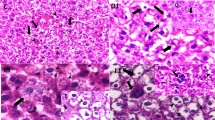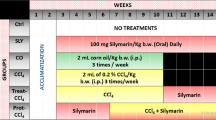Abstract
It has been proven that higher dose of lanthanoid (Ln) can induce liver toxicities, but the mechanisms and the molecular pathogenesis are still unclear. In this study, LaCl3, CeCl3, and NdCl3 at a higher dose of 20 mg/kg body weight was injected into the abdominal cavity of ICR mice for 14 consecutive days, and the inflammatory responses of liver of mice were investigated by histopathological test, real-time quantitative reverse transcription polymerase chain reaction (RT–PCR), and enzyme-linked immunosorbent assay (ELISA) methods. The results showed the significant accumulation of Ln in the liver results in liver histopathological changes and, therefore, liver malfunctions. The real-time quantitative RT–PCR and ELISA analyses showed that Ln could significantly alter the mRNA and protein expressions of several inflammatory cytokines, including nucleic factor-κB, macrophage migration inhibitory factor, tumor necrosis factor-α, interleukin-1β, interleukin-6, cross-reaction protein, interleukin-4, and interleukin-10. Our results also implied that the inflammatory responses and liver injury likely are caused by 4f shell and alterable valence properties of Ln-induced liver toxicity.



Similar content being viewed by others
References
Tsuchiya T, Taketsugu T, Nakano H, Hirao K (1999) Theoretical study of electronic and geometric structures of a series of lanthanide trihalides LnX3 (Ln = La–Lu; X = Cl, F). J Mol Struc-Theochem 203–222
Ni JZ (2002) Bioinorganic chemistry of rare earth elements. Academic, Beijing
Arnd V, Horst K (2006) Excited state properties of lanthanide complexes: beyond ff states. Inorganica Chimica Acta 359:4130–4138
Guo BS, Zhu WM, Xiong BK, Ji YJ, Liu Z, Wu ZM (1990) Application of rare earths in agriculture. Chin Agr Sci Technol Press, Beijing, pp 209–257(in Chinese)
Hong FS, Fang NH, Zhao GW (2000) Physiological effects of Ce(NO3)3 on promoting germination of rice seed. Acta Agr Sin 26(1):7–12 (abstract in English)
Hong FS, Wei ZG, Zhao GW (2000) Effect of lanthanum on aged seed germination of rice. Biol Trace Elem Res 75:205–213
Hong FS, Wei ZG, Zhao GW (2000) Study on mechanism of lanthanum nitrate effected on the vigor of aged rice seed. J Rare Earths 18(3):220–225
Hong FS (2002) Study on the mechanism of cerium nitrate effects on germination of aged rice seed. Biol Trace Elem Res 87:191–200
Liu C, Hong FS, Zheng L, Tang P, Wang ZG (2004) Effects of rare earth elements on vigor enhancement of aged spinach seeds. J Rare Earths 22(4):547–552
Liu XQ, Su MY, Liu C, Hong FS (2007) Effects of 4f electron characteristic and alternation valence of rare earths on photosynthesis: regulating distribution of energy and activities of spinach chloroplast. J Rare Earths 25(4):495–501
Shimada H, Nagano M, Funakoshi T, Kojima S (1996) Pulmonary toxicity of systemic terbium chloride in mice. J Toxicol Environ Health 48(1):81–92
Lu R, Ni JZ (2002) Mechanism of rare earth effect on liver. J Chin Rare Earth Soc 20(3):193–198 (abstract in English)
Feng JH, Li XJ, Pei FK, Chen X, Li SL, Nie YX (2002) 1H NMR analysis for metabolites in serum and urine from rats administrated chronically with La(NO3)3. Anal Biochem 301:1–7
Clayton TA, Lindon JC, Everett JR, Charuel C, Hanton G, Net JLL, Provost JP, Nicholson JK (2003) An hypothesis for a mechanism underlying hepatotoxin-induced hypercreatinuria. Arch Toxicol 77:208–217
Huang KX, Li DM, Nie YX (2002) Effects of low dosage lanthanum nitrate on defence function of free radical in mice kidney. J Chin Rare Earth Soc 20:190–192 (abstract in English)
Huang KX, Li DM, Nie YX, Li SL, Huang KJ (2000) Effects of administration of low dosage La(NO3)3 on SOD and LPO in mice heart. Stud Trace Elem Health 20:1–2 (abstract in English)
Kawagoe M, Hirasawa F, Wang SC, Liu Y, Ueno Y, Sugiyama T (2005) Orally administrated rare earth element cerium induces metallothionein synthesis and increases glutathione in the mouse liver. Life Sci 77:922–937
Liu Y, Chen D, Chen AJ, Liu B, Sun SY, Nie YX (2001) Subchronic toxicity of lanthanum nitrate on liver of rats. J Chin Rare Earth Soc 19:167–170 (abstract in English)
Shen ZG, Lei HY, Wei Q, Yang XF, Zuang ZX, Yang YS (1999) Effect of cerium ion on cAMP and cGMP of primary hepatocyte and organs in rat. Chin Rare Earths 20(4):42–45 (abstract in English)
Shen ZG, Lei HY, Wei Q, Yang XF, Zuang ZX, Yang YS (2001) Effect of Ce3+ on the activities of ATPase of hepatocytes. Chin Rare Earths 22(1):35–37 (abstract in English)
Xia Q, Chen D, Liu YR, Chen AJ (2006) Effect of mixed rare earth oxide “Changle” on rat liver. Chin Rare Earths 27(3):76–78 (abstract in English)
Wu HF, Zhang XY, Liao PQ, Li ZF, Li WH, Li XJ, Wu YJ, Pei FK (2005) NMR spectroscopic-based metabonomic investigation on the acute biochemical effects induced by Ce(NO3)3 in rats. J Inorg Biochem 99:2151–2160
Wu H, Li XI, Li ZF, Liao PQ, Wu YI, Pei FK (2006) Comparison of biochemical effects induced by “Changle” between male and female rats using NMR and ICP–MS techniques. J Rare Earths 24:108–114
Yang WD, Wang T, Lei HY, Yang YS (1999) Effect of cerium nitrate on the activity of ATPase in rat tissues. J Hyg Res 29(6):329–355 (abstract in English)
Zhang ZG, Shen XY, Xu XL, Wu AF (2004) Effects of cerium nitrate on learning-memory and antioxidation of rats. J Zhejiang Normal Univ 24:167–170 (abstract in English)
Yang WD, Wang T, Lei HY, Yang YS (1999) Study on the hepatic toxicity of cerous nitrate in rats. J Hygiene Res 28(2):91–94 (abstract in English)
Li ZF, Wu HF, Zhang XY, Li XJ, Liao PQ, Li WS, Pei FK (2006) Investigation on the acute biochemical effects of light rare earths (lanthanum and cerium) by NMR-based metabonomic approaches. Chem J Chin U 27:438–442
Liao PQ, Zhang XY, Wang T, Sheng LW, Wu YJ, Li XJ, Ni JZ, Pei FK (2008) Studies on the acute biochemical effects of Nd(NO3)3 by nuclear magnetic resonance-based metabonomics. Chin J Anal Chem 36:426–432
Liao PQ, Wu HF, Zhang XY, Jing LX, Feng LZ, Sheng LW, Wu YJ, Pei FK (2006) Comparative investigation on acute biological effect of lanthanum and cerium by MAS 1H NMR-based metabonomic approach. Chem J Chin U 27:1448–1452
Ghosh S, May MJ, Kopp EB (1998) NF-kappa B and Rel proteins: evolutionarily conserved mediators of immune responses. Annu Rev Immunol 16:225–260
Livak KJ, Schmittgen TD (2001) Analysis of relative gene expression data using real-time quantitative PCR and the 2(−Delta Delta C(T)) method. Methods 25:402–408
Ke LD, Chen Z (2000) A reliability test of standard-based quantitative PCR: exogenous vs endogenous standards. Mol Cell Probes 14(2):127–35
Liu WH, Saint DA (2002) Validation of a quantitative method for real time PCR kinetics. Biochem Biophys Res Commun 294:347–353
Nie YX, Huang KX, Zhou L, Cui N (1997) Histochemical and electromicroscopic observation on effects of low dose chlorides of lanthanum and ytterbium on rat liver. J N Bethune Univ Med Sci 23(2):117–119 (abstract in English)
Tu HM, Yang YS, Li Y, Wang ED (2000) Effect of rare earth ions on kinetic properties of Escherichia coli leucyl-tRNA synthetase. J Rare Earths 18(3):224–228
Grajewski O, Lehmann BV, Arntz HR, Arvela P, Oberdisse E (1977) Alteration of rat serum lipoproteins and lecithin–cholesterol–acyltransferase activity in praseodymium-induced liver damage. N-S Arch Pharm 301(1):65–73
Lenmann BV, Oberdisse E, Grajewski O, Arntz HR (1975) Subcellular distribution of phospholipids during liver damage induced by rare earth. Arch Toxicol 34(2):89–101
Glenn JL, Tischer K, Stein A (1962) Rare earth fatty liver I. Octanoate oxidation and energy production. BBA 62(1):35–40
Kyker GC, Cress EA (1957) Acute toxicity of yttrium, lanthanum and other rare earths. Am Med Assoc Arch Ind Health 16:475–479
Wei QH, Qin SY, Qin ZJ, Huang YQ (2002) An experimental study of the effect of cadmium poisoning on immunologic function in rats. Practical Prevent Med 9(5):460–462
Ye XB, Liu SF (2001) Lipopolysaccharide regulates constitutive and inducible transcription factor activities differentially in vivo in the rat. Biochem Biophys Res Commun 288(4):927–932
Bhakar AL, Tannis LL, Zeindler C, Russo MP, Jobin C, Park DS, MacPherson S, Barker PA (2002) Constitutive nuclear factor-kappa B activity is required for central neuron survival. J Neurosci 22(19):8466–8475
Liu HX, Yang XD, Wang K (2006) Effects of lanthanide ions (La3+, Gd3+, Yb3+) on production of reactive oxygen species in mitochondria. Chem J Chin Univ 27(6):999–1002 (abstract in English)
Acknowledgments
Project supported by the National Natural Science Foundation of China (grant no. 30901218) and by the Medical Development Foundation of Soochow University of China (grant no. EE120701) and the Soochow University Start-up Fund (grant no. Q4134918).
Author information
Authors and Affiliations
Corresponding author
Additional information
The authors Min Fei, Na Li, Yuguan Ze, Jie Liu, and Sisi Wang contributed equally to this work.
Rights and permissions
About this article
Cite this article
Fei, M., Li, N., Ze, Y. et al. The Mechanism of Liver Injury in Mice Caused by Lanthanoids. Biol Trace Elem Res 140, 317–329 (2011). https://doi.org/10.1007/s12011-010-8698-x
Received:
Accepted:
Published:
Issue Date:
DOI: https://doi.org/10.1007/s12011-010-8698-x




